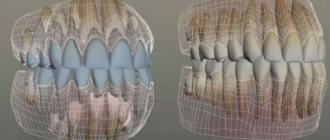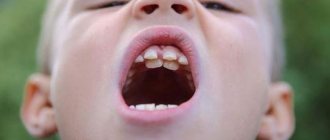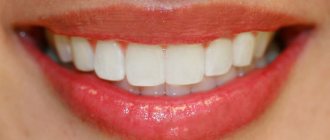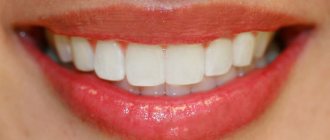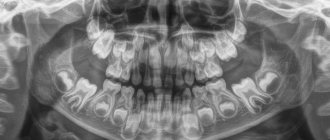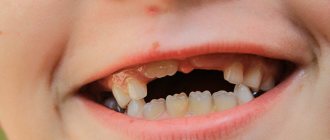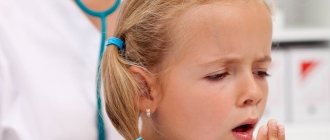Author of the article:
Soldatova Lyudmila Nikolaevna
Candidate of Medical Sciences, Professor of the Department of Clinical Dentistry of the St. Petersburg Medical and Social Institute, Chief Physician of the Alfa-Dent Dental Clinic, St. Petersburg
Cigarette plaque on teeth is an extremely unpleasant consequence of active smoking. It gradually accumulates on the enamel, causing its color to change.
When you abuse tobacco, your smile takes on a pronounced yellow or even dark brown tint, and unsightly stains appear on your teeth that cannot be removed with a brush.
The change in enamel color is a consequence of exposure to substances that are part of smoke, such as nicotine, phenolic and ammonia compounds, and tar. All of them firmly settle on the porous surface of the teeth, penetrating deeper and deeper over time, which leads to the fact that the yellowness becomes more and more pronounced.
The worse a smoker cares about oral health, the faster plaque forms, which ultimately leads not only to aesthetic problems, but also to deterioration in the quality of enamel.
If measures are not taken in a timely manner, the yellow plaque turns into gray-brown. This leads to inflammation of the gums and impaired blood circulation in them. Bleeding, periodontal disease, caries and tartar may occur. Further, the smoker may experience tooth loss, so it is worth paying attention and addressing the problem in a timely manner.
How cigarettes affect teeth
The main symptoms of oral disease that appear in smokers can be identified:
- gums become pale pink;
- periodontal tissues are not inflamed;
- the cervical surfaces of the teeth are covered with a dark brown coating;
- Possible bad breath.
Types of cigarette plaque
Plaque caused by smoking varies in color:
- White plaque forms throughout the day or at night. This is a soft plaque, the appearance of which is also promoted by eating food. It is not dangerous to health and can be easily eliminated with thorough brushing of your teeth.
- Green plaque is a consequence of deformation of the pellicle or exposure to a chromogenic fungus.
- Yellow and brown plaque is evidence of addiction to cigarettes, strong coffee or tea. It is formed due to exposure to pigments contained in smoke or products. Only dentists can completely remove stains or remove plaque from cigarettes on teeth. Professional cleaning and bleaching will be required.
- Black plaque. Teeth turn black from cigarettes if the development of processes that lead to yellow and gray plaque has not been stopped.
Effect of smoke
The resinous substances contained in tobacco smoke gradually settle on the surface of the enamel and cover it with a thin but very durable film of plaque. Even a small amount is enough for the development of pathogenic microorganisms. Their accumulation not only negatively affects the appearance, but also leads to the destruction of tooth tissue.
Also, smoke greatly dries out the oral mucosa due to its high temperature. As a result, a smaller amount of salivary fluid is produced, and it is known to have a powerful bactericidal effect. As a result, the risk of developing caries and other pathologies increases several times.
Harmful substances contained in tobacco negatively affect tissue regeneration, which slows down treatment and recovery after surgery. Even small wounds heal much more slowly, and the person feels severe discomfort.
How to remove plaque on teeth from cigarettes at home
Home remedies won't completely get rid of cigarette residue, but they can help reduce its impact.
Regular teeth cleaning
Every smoker should understand that their teeth require more careful care. Brush your teeth at least twice a day, and preferably after every major meal. Give this process at least five minutes. There should be about 20 movements per tooth. Clean the outer side first, then move on to the chewing surface and the inner edge of the side teeth. Finally, clean your tongue and rinse your mouth. For hygiene, it is better to use specialized pastes and rinses; they will make the procedure more effective.
Home whitening with folk remedies
As bleaching agents, you can use soda, activated carbon and lemon, as well as hydrogen peroxide (Attention: peroxide should never be swallowed!). Simply apply the substance to the surface of the tooth. It is important to remember that such procedures can be performed no more than twice a week and it is necessary to take long breaks. Otherwise, you will damage the enamel, which will only lead to bigger problems. This type of whitening will not help completely remove stains from cigarettes, but it will make the color of your smile a couple of shades lighter.
Whitening with special means
There are many special products available for home removal of yellow stains from tooth enamel. These can be whitening strips or a professional gel, which is applied with a brush and requires the use of a protective mouthguard. Before you start using these products, you should consult your dentist.
Smoking and tooth extraction
The question of how safe it is to smoke after tooth extraction worries many smokers. The procedure itself is associated with a certain amount of stress, and therefore many patients involuntarily have the urge to smoke a cigarette after visiting the dentist’s office. It is believed that this way you can get a certain calming effect. However, it is still better to refrain from this ritual, because nicotine and tar can have an irritating effect on an open wound. Otherwise, there is a risk of bleeding and pain. In addition, tobacco smoke slows down the healing process.
Important! After wisdom tooth removal, all precautions must be observed especially strictly. Often, such an operation is complicated by an overly branched and tangled root system, which the doctor is forced to remove in stages. If you smoke, be sure to tell your dentist this, and at the same time clarify how long after removal you can smoke a cigarette.
The patient will have to be patient and wait at least 2 hours after the procedure. It is important to wait until the bleeding stops completely. Another unpleasant consequence can be the so-called dry socket, while the presence of a protective blood clot in it is an extremely important condition for preventing wound infection.
How to remove cigarette plaque on teeth: clinical methods
There are several effective ways to completely remove plaque formed as a result of smoking.
The first option is professional cleaning. It can be carried out using an AirFlow device, which supplies a solution with crushed abrasives under pressure. You can also remove stones and plaque using ultrasound. In addition, plaque is removed manually using special instruments - scalers and curettes.
The second option is chemical bleaching. It is carried out after cleaning and is a purely cosmetic procedure, since it does not provide any benefits to dental health, but after a few sessions you can get a radiant white smile. Chemical whitening involves applying specialized gels based on hydrogen peroxide. The gel is applied for half an hour or more, in addition, its action can be activated by a laser or light from a halogen lamp (photobleaching).
After you have cleaned your teeth of plaque, you need to take good care of them. Ideally, quit smoking altogether or at least reduce the number of cigarettes. Remember to brush your teeth thoroughly and regularly, eat less coloring products, and use specialized toothpastes.
Smoking and implantation
Unfortunately, such concepts as smoking and dental implants are practically incompatible. Patients who smoke are much more likely to experience implant failure , especially if they smoke during osseointegration.
Smoking several months before the procedure is no less harmful. Much the same can be said about prosthetics – it is much more difficult for smoking patients to adapt to wearing prostheses, and they often experience complications and side effects.
IMPORTANT: Unfortunately, concepts such as smoking and dental implants are practically incompatible. Patients who smoke are much more likely to experience implant failure, especially if they smoke during osseointegration.
Clinical trials
Clinical studies have proven that regular use of professional toothpaste ASEPTA COFFEE AND TOBACCO for a month improved the hydration of the mucous membrane by 3.3 times, the remineralizing efficiency increased by 3.9 times, at the same time, the cleansing effect has increasing dynamics and reaches 60 .5% at 4 weeks of use.
Sources:
- Report on determining/confirming the preventive properties of toothpaste “ASEPTA PLUS” COFFEE and TOBACCO Author: doctor-researcher A.A. Leontyev, head Department of Preventive Dentistry, Doctor of Medical Sciences, Professor S.B. Ulitovsky. First St. Petersburg State Medical University named after. acad. I.P. Pavlova, Department of Preventive Dentistry
- Report on determining/confirming the preventive properties of toothpaste “ASEPTA PLUS” GENTLE WHITENING” Author: doctor-researcher A.A. Leontyev, head Department of Preventive Dentistry, Doctor of Medical Sciences, Professor S.B. Ulitovsky First St. Petersburg State Medical University named after. acad. I.P. Pavlova, Department of Preventive Dentistry
- Clinical and laboratory assessment of the influence of domestic therapeutic and prophylactic toothpaste based on plant extracts on the condition of the oral cavity in patients with simple marginal gingivitis. Doctor of Medical Sciences, Professor Elovikova T.M.1, Candidate of Chemical Sciences, Associate Professor Ermishina E.Yu. 2, Doctor of Technical Sciences Associate Professor Belokonova N.A. 2 Department of Therapeutic Dentistry USMU1, Department of General Chemistry USMU2
- Report on the determination/confirmation of the preventive properties of personal oral hygiene products “ASEPTA PLUS” Remineralization doctor-researcher A.A. Leontyev, head Department of Preventive Dentistry, Doctor of Medical Sciences, Professor S.B. Ulitovsky First St. Petersburg State Medical University named after. acad. I.P. Pavlova, Department of Preventive Dentistry
- Clinical studies of antisensitive toothpaste “Asepta Sensitive” (A.A. Leontyev, O.V. Kalinina, S.B. Ulitovsky) A.A. LEONTIEV, dentist O.V. KALININA, dentist S.B. ULITOVSKY, Doctor of Medical Sciences, Prof. Department of Therapeutic Dentistry, St. Petersburg State Medical University named after. acad. I.P. Pavlova
- The role of anti-inflammatory rinse in the treatment of periodontal diseases (L.Yu. Orekhova, A.A. Leontyev, S.B. Ulitovsky) L.Yu. OREKHOVA, Doctor of Medical Sciences, Prof., Head of Department; A.A. LEONTIEV, dentist; S.B. ULITOVSKY, Doctor of Medical Sciences, Prof. Department of Therapeutic Dentistry of St. Petersburg State Medical University named after. acad. I. P. Pavlova
List of prohibited products
In the first two weeks, you need to treat your teeth especially carefully. Hot and cold food is prohibited; everything should be moderately warm. There is no need to expose the enamel to even mild acid, so you will have to exclude fermented milk products.
With a white diet, you eat everything that is light in color. Animal products include:
- white meat and fish,
- egg white,
- soft cheese (mild and without spices),
- fresh milk,
- butter.
The following herbal products are acceptable:
- rice,
- pearl barley,
- cereals,
- white beans,
- potato,
- pasta,
- flour products (only without sugar and coloring ingredients),
- light mushrooms (champignons or porcini),
- light vegetable oil,
- white sweet pepper,
- peeled cucumbers,
- bananas,
- white and clear drinks (non-alcoholic).
The remaining vegetables and fruits are divided into two groups: unacceptable and conditionally acceptable. For example, beets or carrots are prohibited in any form. Conditionally acceptable include those for which heat treatment is sufficient to destroy the acid and weak pigment. For example, boiled cabbage or sour baked apples without peel.
Do not use:
- dairy products;
- egg yolk;
- red fish;
- red meat;
- sausage and ham (contains dyes);
- light fruits (if they are sour and have peel);
- colored fruits and vegetables;
- greenery;
- unpeeled cucumbers;
- sweets;
- spices, sauces, vinegar;
- colored drinks (including coffee, black and even green tea);
- alcohol.
- In the first four days after bleaching, you must strictly follow the rules. From the 5th day you can allow yourself relaxations, but small ones. For example, drink green tea through a straw or fermented baked milk, then immediately brush your teeth or rinse your mouth.
It is advisable to adhere to a white diet for a month, the minimum required period is 14 days. At this time, it is not yet recommended to paint your lips, since accidentally getting gloss or lipstick on the enamel is equivalent to using a coloring product.
Lips
If you have been smoking for many years, then you are almost certainly familiar with the problem of dry lips. The thing is that smokers produce less saliva (the body refuses to perceive a cigarette as something edible), so a person experiences a feeling of dryness and involuntarily licks his lips. At the same time, they lose their protective water-fat film and instantly become weathered in the air. As a result, inflammation of the red border of the lips develops - cheilitis.
Your actions. Use a special moisturizing lipstick with medicinal ingredients, such as cocoa butter, almond oil, and chamomile extract. You can also lubricate your skin with a softening baby cream with vitamins A and E before going to bed.
It is also worth paying attention to toothpaste - sometimes it worsens the condition of the lips. Pastes containing fluoride are especially aggressive on the skin and can cause persistent irritation. Give them up for a while and choose pastes with herbal anti-inflammatory ingredients.


